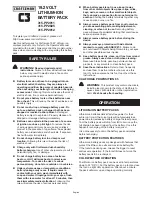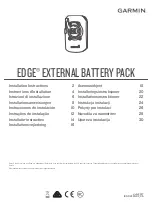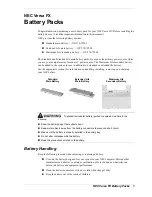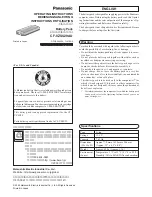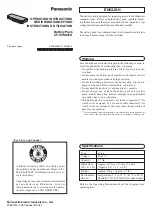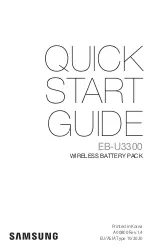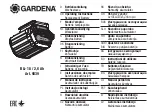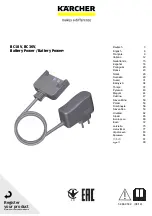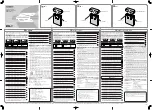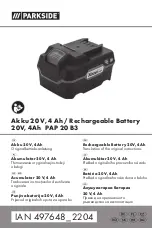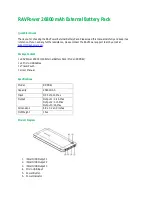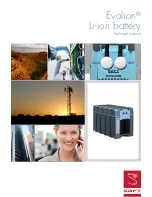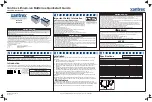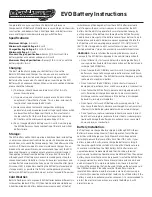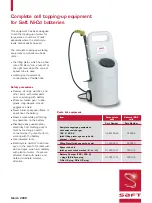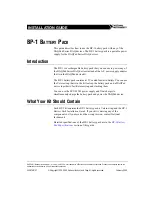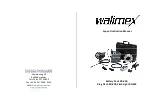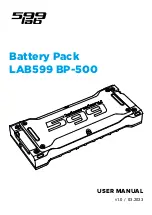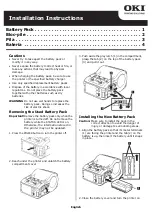
English
WARNING!
Read and understand all
instructions.
Failure to follow all instructions listed
below, may result in electric shock, fire and/or
serious personal injury.
Battery tools do not have to be plugged into an
electrical outlet; therefore, they are always in
operating condition. Be aware of possible hazards
when not using your battery tool or when changing
accessories.
Following this rule will reduce the risk of
electric shock, fire, or serious personal injury.
Do not place battery tools or their batteries near
fire or heat.
This will reduce the risk of explosion and
possibly injury.
Do not crush, drop or damage battery pack. Do
not use a battery pack or charger that has been
dropped or received a sharp blow.
A damaged
battery is subject to explosion. Properly dispose of a
dropped or damaged battery immediately.
Batteries can explode in the presence of a source
of ignition, such as a pilot light.
To reduce the risk
of serious personal injury, never use any cordless
product in the presence of open flame. An exploded
battery can propel debris and chemicals. If exposed,
flush with water immediately.
Do not charge battery tool in a damp or wet
location.
Following this rule will reduce the risk of
electric shock.
Charge only with Craftsman dual-chemistry
battery chargers.
Use of other chargers may result in
personal injury, fire, or damage
.
Do not charge battery in an area of extreme
heat or cold. It will work best at normal room
temperature. To reduce the risk of serious
personal injury, do not store outside or in vehicles.
Under extreme usage or temperature conditions,
battery leakage may occur. If liquid comes in
contact with your skin, wash immediately with
soap and water. If liquid gets into your eyes, flush
them with clean water for at least 10 minutes, then
seek immediate medical attention.
Following this
rule will reduce the risk of serious personal injury.
When battery pack is not in use, keep it away
from other metal objects like: paper clips, coins,
keys, nails, screws, or other small metal objects
that can make a connection from one terminal to
another.
Shorting the battery terminals together may
cause sparks, burns, or a fire.
Always remove battery pack from your tool when
you are assembling parts, making adjustments,
cleaning, or when not in use.
Removing battery
pack will prevent accidental starting that could cause
serious personal injury.
Always remove battery pack before storing the
device.
Always wear eye protection with side shields
marked to comply with ANSI Z87.1.
Failure to do
so could result in objects being thrown into your eyes
and other possible serious injuries.
Keep battery pack dry, clean, and free from oil and
grease. Always use a clean cloth when cleaning.
Never use brake fluids, gasoline, petroleum-based
products, or any solvents to clean battery pack.
Save these instructions.
Refer to them frequently
and use them to instruct others who may use this
tool. If you loan someone this tool, loan them these
instructions.
CALIFORNIA PROPOSITION 65
WARNING:
This product may contain chemicals,
including lead, known to the state of California to
cause cancer, birth defects or other reproductive
harm.
Wash hands after handling.
LITHIUM-ION BATTERY PACKS
Lithium-ion batteries deliver fade free power for their
entire run time. Lithium-ion tools will not gradually lose
power due to decreasing battery charge. Instead, power
from the battery pack will drop from full to zero once the
full charge has been drained from the battery. Once this
happens, recharging of the battery is required.
It is not necessary to drain the battery pack completely
before recharging.
BATTERY PROTECTION FEATURES
Lithium-ion battery packs are designed with features that
protect the lithium-ion cells and maximize battery life.
If the tool stops during use, release the trigger to reset
and resume operation. If the tool still does not work, the
battery needs to be recharged.
COLD WEATHER OPERATION
The lithium-ion battery pack can be used in temperatures
down to 32°F (0°C). Put the battery pack on a tool and use
the tool in a light duty application. After about a minute,
the pack will warm up and begin operating normally.
SAFETY RULES
OPERATION
To register your Craftsman product, please visit:
http://www.sears.com/craftsman
Use this battery pack for Craftsman 19.2V Lithium-ion
cordless products only. Refer to the Operator’s Manual
provided with product. Always mention the model number
above when communicating with us regarding this battery
pack.
19.2 VOLT
LITHIUM-ION
BATTERY PACK
315.PP2011
315.PP2025
315.PP2012

